1. Nature of Universe
Importance of Hubble Space Telescope:
- The Hubble Space Telescope and powerful ground-based telescopes are now beginning to find galaxies that were created about one billion years after the Big Bang.
- These small galaxies were much closer together than galaxies are today.
- Collisions were common.
- Like two flames moving towards each other, they merged into bigger galaxies.
- Our Milky Way galaxy came together in this way.
Cosmic Constraints:
- The basic constituent of the universe is luminous matter i.e., galaxies which are really the collection of billions of stars.
- The universe contains everything that exists including the Earth, planets, stars, space, and galaxies.
- This includes all matter, energy and even time.
- No one knows how big the universe is.
- It could be infinitely large.
- Scientists, however, measure the size of the universe by what they can see.
- This is called the ‘observable universe’.
- The observable universe is around 93 billion light years (1 light year = the distance that light travels in one year, which is 9.4607 × 1012km) across.
- One of the interesting things about the universe is that it is currently expanding.
- It is growing larger and larger all the time.
- Not only is it growing larger, but the edge of the universe is expanding at a faster and faster rate.
- However, most of the universe what we think of is empty space.
- All the atoms together only make up around four percent of the universe.
- The majority of the universe consists of something scientists call dark matter and dark energy.
Age of the Universe:
- Scientists think that the universe began with the start of a massive explosion called the Big Bang.
- According to Big Bang theory, all the matter in the universe was concentrated in a single point of hot dense matter.
- About 13.7 billion years ago, an explosion occurred and all the matter were ejected in all directions in the form of galaxies.
- Nearly all of the matter in the universe that we understand is made of hydrogen and helium, the simplest elements, created in the Big Bang.
- The rest, including the oxygen, the carbon, calcium, and iron, and silicon are formed in the cores of stars.
- The gravity that holds these stars together generally keeps these elements deep inside their interiors.
- When these stars explode, these fundamental building blocks of planetary systems are liberated throughout the universe.
Galaxy & Milky Way:
- Immediately after the Big Bang, clouds of gases began to compress under gravity to form the building blocks of galaxies.
- A galaxy is a massive collection of gas, dust, and billions of stars and their solar systems.
- Scientists believe that there are one hundred billion (1011) galaxies in the observable universe.
- Galaxies are also in different shapes.
- Depending on their appearance, galaxies are classified as spiral, elliptical, or irregular.
- Galaxies occur alone or in pairs, but they are more often parts of groups, clusters, and super clusters.
- Galaxies in such groups often interact and even merge together.
- Our Sun and all the planets in the solar system are in the Milky Way galaxy.
- There are many galaxies besides our Milky Way.
- Andromeda galaxy is our closest neighboring galaxy.
- The Milky Way galaxy is spiral in shape.
- It is called Milky Way because it appears as a milky band of light in the sky.
- It is made up of approximately 100 billion stars and its diameter is 1, 00,000 light years.
- Our solar system is 25,000 light years away from the centre of our galaxy.
- Just as the Earth goes around the Sun, the Sun goes around the centre of the galaxy and it takes 250 million years to do that.
Constellations:
- Stars are the fundamental building blocks of galaxies.
- Stars were formed when the galaxies were formed during the Big Bang.
- Stars produce heat, light, ultraviolet rays, x-rays, and other forms of radiation.
- They are largely composed of gas and plasma (a superheated state of matter).
- Stars are built by hydrogen gases.
- Hydrogen atoms fuse together to form helium atoms and in the process they produce large amount of heat.
- In a dark night we can see nearly 3,000 stars with the naked eye.
- We don’t know how many stars exist.
- Our universe contains more than 100 billion galaxies, and each of those galaxies may have more than 100 billion stars.
- Though the stars appear to be alone, most of the stars exist as pairs.
- The brightness of a star depends on their intensity and the distance from the Earth.
- Stars also appear to be in different colours depending on their temperature.
- Hot stars are white or blue, whereas cooler stars are orange or red in colour.
- They also occur in many sizes.
- A group of stars forms an imaginary outline or meaningful pattern on the space.
- They represent an animal, mythological person or creature, a god, or an object.
- This group of stars is called constellations.
- People in different cultures and countries adopted their own sets of constellation outlines.
- There are 88 formally accepted constellations.
- Aries, Gemini, Leo, Orion, Scorpius and Cassiopeia are some of the constellations.
Solar System:
- Sun and the celestial bodies which revolve around it form the solar system.
- It consists of large number of bodies such as planets, comets, asteroids and meteors.
- The gravitational force of attraction between the Sun and these objects keep them revolving around it.
Sun:
- The Sun is a medium sized star, a very fiery spinning ball of hot gases.
- Three quarters of the Sun has hydrogen gas and one quarter has helium gas.
- It is over a million times as big as the Earth.
- Hydrogen atoms combine or fuse together to form helium under enormous pressure.
- This process, called nuclear fusion releases enormous amount of energy as light and heat.
- It is this energy which makes Sun shine and provide heat.
- Sun is situated at the centre of the solar system.
- The strong gravitational fields cause other solar matter, mainly planets, asteroids, comets, meteoroids and other debris, to orbit around it.
- Sun is believed to be more than 4.6 billion years old.
Formation of the Sun:
- At the time of the Big Bang, hydrogen gas condensed to form huge clouds, which later concentrated and formed the numerous galaxies.
- Some of the hydrogen gas was left free and started floating around in our galaxy.
- With time, due to some changes, this free-floating hydrogen gas concentrated and paved way for the formation of the Sun and solar system.
- Gradually, the Sun and the solar system turned into a slowly spinning molecular cloud, composed of hydrogen and helium along with dust.
- The cloud started to undergo the process of compression, as a result of its own gravity.
- Its excessive and high-speed spinning ultimately resulted in its flattening into a giant disc.
Planets:
- A planet revolves around the Sun along a definite curved path which is called an orbit.
- It is elliptical.
- The time taken by a planet to complete one revolution is called its period of revolution.
- Besides revolving around the Sun, a planet also rotates on its own axis like a top.
- The time taken by a planet to complete one rotation is called its period of rotation.
- The period of rotation of the Earth is 23 hours and 56 minutes and so the length of a day on Earth is taken as 24 hours.
- The planets are spaced unevenly.
- The first four planets are relatively close together and close to the Sun.
- They form the inner solar system. Farther from the Sun is the outer solar system, where the planets are much more spread out.
- The distance between Saturn and Uranus is much greater (about 20 times) than the distance between the Earth and the Mars.
Mercury:
- Mercury is a rocky planet nearest to the Sun.
- It is very hot during day but very cold at night.
- Mercury can be easily observed thorough telescope than naked eye since it is very faint and small.
- It always appears in the eastern horizon or western horizon of the sky.
Venus:
- Venus is a special planet from the Sun, almost the same size as the Earth.
- It is the hottest planet in our solar system.
- After our moon, it is the brightest heavenly body in our night sky.
- This planet spins in the opposite direction to all other planets.
- So, unlike Earth, the Sun rises in the west and sets in the east here.
- Venus can be seen clearly through naked eye.
- It always appears in the horizon of eastern or western sky.
Earth:
- The Earth where we live is the only planet in the solar system which supports life.
- Due to its right distance from the Sun, it has the right temperature, the presence of water and suitable atmosphere and a blanket of ozone.
- All these have made continuation of life possible on the Earth.
- From space, the Earth appears bluish green due to the reflection of light from water and land mass on its surface.
Mars:
- The first planet outside the orbit of the Earth is Mars.
- It appears slightly reddish and therefore it is also called the red planet.
- It has two small natural satellites (Deimos and Phobos).
Jupiter:
- Jupiter is called as Giant planet.
- It is the largest of all planets (about 11 times larger and 318 times heavier than Earth).
- It has 3 rings and 65 moons. Its moon Ganymede is the largest moon of our solar system.
Saturn:
- Known for its bright shiny rings, Saturn appears yellowish in colour.
- It is the second biggest and a giant gas planet in the outer solar system.
- At least 60 moons are present – the largest being Titan.
- Titan is the only moon in the solar system with clouds.
- Having least density of all (30 times less than Earth), this planet is so light.
Uranus:
- Uranus is a cold gas giant and it can be seen only with the help of large telescope.
- It has a greatly tilted axis of rotation.
- As a result, in its orbital motion it appears to roll on its side.
- Due to its peculiar tilt, it has the longest summers and winters each lasting 42 years.
Neptune:
- It appears as greenish star.
- It is the eighth planet from the Sun and is the windiest planet.
- Every 248 years, Pluto crosses its orbit.
- This situation continues for 20 years.
- It has 13 moons – Triton being the largest.
- Triton is the only moon in the solar system that moves in the opposite direction to the direction in which its planet spins.
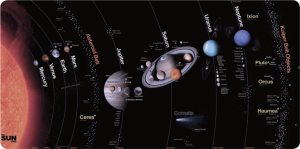
- Besides the eight planets, there are some other bodies which revolve around the Sun.
- They are also members of the solar system.
Asteroids:
- There is a large gap in between the orbits of Mars and Jupiter.
- This gap is occupied by a broad belt containing about half a million pieces of rocks that were left over when the planets were formed and now revolve around the Sun.
- These are called asteroids.
- The biggest asteroid is Ceres – 946 km across.
- Every 50 million years, the Earth is hit by an asteroid nearing 10 km across.
- Asteroids can only be seen through large telescope.
Comets:
- Comets are lumps of dust and ice that revolve around the Sun in highly elliptical orbits.
- Their period of revolution is very long.
- When approaching the Sun, a comet vaporizes and forms a head and tail.
- Some of the biggest comets ever seen had tails 160 million (16 crores) km long. This is more than the distance between the Earth and the Sun.
- Many comets are known to appear periodically.
- One such comet is Halley’s Comet, which appears after nearly every 76 years.
- It was last seen in 1986.
- It will next be seen in 2062.
Meteors and Meteorites:
- Meteors are small piece of rocks scattered throughout the solar system.
- Traveling with high speed, these small pieces come closer to the Earth’s atmosphere and are attracted by the gravitational force of Earth.
- Most of them are burnt up by the heat generated due to friction in the Earth’s atmosphere.
- They are called meteors.
- Some of the bigger meteors may not be burnt completely and they fall on the surface of Earth.
- These are called meteorites.
Satellites:
- A body moving in an orbit around a planet is called satellite.
- In order to distinguish them from the man made satellites (called as artificial satellites), they are called as natural satellites or moons.
- Satellite of the Earth is called Moon (other satellites are written as moon).
- We can see the Earth’s satellite Moon, because it reflects the light of the Sun.
- Satellite moves around the planets due to gravity, and the centripetal force.
- Among the planets in the solar system all the planets have moons except Mercury and Venus.
State the importance of rotation and release velocity:
- We saw that there are natural satellites moving around the planets.
- There will be gravitational force between the planet and satellites.
- Nowadays many artificial satellites are launched into the Earth’s orbit.
- The first artificial satellite Sputnik was launched in 1956.
- India launched its first satellite Aryabhatta on April 19, 1975.
- Artificial satellites are made to revolve in an orbit at a height of few hundred kilometers.
- At this altitude, the friction due to air is negligible.
- The satellite is carried by a rocket to the desired height and released horizontally with a high velocity, so that it remains moving in a nearly circular orbit.
- The horizontal velocity that has to be imparted to a satellite at the determined height so that it makes a circular orbit around the planet is called orbital velocity.
- The orbital velocity of the satellite depends on its altitude above Earth.
- Nearer the object to the Earth, the faster is the required orbital velocity.
- At an altitude of 200 kilometers, the required orbital velocity is little more than 27,400 kph.
- That orbital speed and distance permit the satellite to make one revolution in 24 hours.
- Since Earth also rotates once in 24 hours, a satellite stays in a fixed position relative to a point on Earth’s surface.
- Because the satellite stays over the same spot all the time, this kind of orbit is called ‘geostationary’.
- Orbital velocity can be calculated using the following formula.

G = Gravitational constant (6.673 × 10–11 Nm2 kg-2)
M = Mass of the Earth (5.972 × 1024 kg)
R = Radius of the Earth (6371 km)
h = Height of the satellite from the surface of the Earth.
Escape Speed:
- Hydrogen and helium are the most abundant elements in the universe but Earth’s atmosphere consists mainly of nitrogen and oxygen.
- The following discussion brings forth the reason why hydrogen and helium are not found in abundance on the Earth’s atmosphere.
- When an object is thrown up with some initial speed it will reach a certain height after which it will fall back to Earth.
- If the same object is thrown again with a higher speed, it reaches a greater height than the previous one and falls back to Earth.
- This leads to the question of what should be the speed of an object thrown vertically up such that it escapes the Earth’s gravity and would never come back.
- Consider an object of mass M on the surface of the Earth.
- When it is thrown up with an initial speed vi , the initial total energy of the object is

- Where, M E is the mass of the Earth and RE – the radius of the Earth.
- The term − GMME / RE is the potential energy of the mass M.
- When the object reaches a height far away from Earth and hence treated as approaching infinity, the gravitational potential energy becomes zero [U( ) = 0] and the kinetic energy becomes zero as well.
- Therefore, the final total energy of the object becomes zero.
- This is for minimum energy and for minimum speed to escape.
- Otherwise, Kinetic energy can be nonzero.

According to the law of energy conservation,
Substituting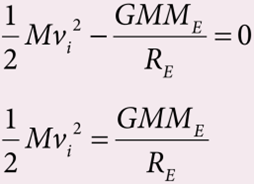
- Consider the escape speed, the minimum speed required by an object to escape Earth’s gravitational field, hence replace vi with ve. i.e,


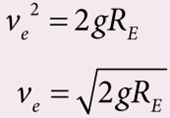
- From equation the escape speed depends on two factors: acceleration due to gravity and radius of the Earth.
- It is completely independent of the mass of the object.
- By substituting the values of g (9.8 m s−2) and Re = 6400km, the escape speed of the Earth is ve = 11.2km s-1.
- The escape speed is independent of the direction in which the object is thrown. Irrespective of whether the object is thrown vertically up, radially outwards or tangentially it requires the same initial speed to escape Earth’s gravity.
- Lighter molecules such as hydrogen and helium have enough speed to escape from the Earth, unlike the heavier ones such as nitrogen and oxygen.
Time period of a Satellite:
- Time taken by a satellite to complete one revolution round the Earth is called time period.

Substituting the value of v, we get
Kepler’s laws:
- In the early 1600s, Johannes Kepler proposed three laws of planetary motion.
- Kepler was able to summarize the carefully collected data of his mentor, Tycho Brahe with three statements that described the motion of planets in a Sun-centered solar system.
- Kepler’s efforts to explain the underlying reasons for such motions are no longer accepted;
- nonetheless, the actual laws themselves are still considered an accurate description of the motion of any planet and any satellite.
- Kepler’s three laws of planetary motion can be described as below.
First Law – The Law of Ellipses:
- All planets revolve around the Sun in elliptical orbits with Sun at one of their foci.
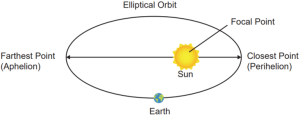
Second Law – The Law of Equal Areas:
- The line connecting the planet and the Sun covers equal areas in equal intervals of time.
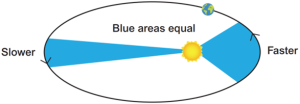
Third Law – The Law of Harmonies:
- The square of time period of revolution of a planet around the Sun is directly proportional to the cube of the distance between sun and the planets.
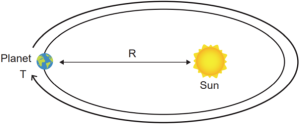
International Space Station (ISS):
- ISS is a large spacecraft which can house astronauts.
- It goes around in low Earth orbit at approximately 400 km distance.
- It is also a science laboratory.
- It’s very first part was placed in orbit in 1998 and its core construction was completed by 2011.
- It is the largest man-made object in space which can also be seen from the Earth through the naked eye.
- The first human crew went to the ISS in 2000.
- Ever since that, it has never been unoccupied by humans.
- At any given instant, at least six humans will be present in the ISS.
- According to the current plan, ISS will be operated until 2024, with a possible extension until 2028.
- After that, it could be deorbited, or recycled for future space stations.
Benefits of ISS:
- According to NASA, the following are some of the ways in which the ISS is already benefitting us or will benefit us in the future.
Supporting water-purification efforts:
- Using the technology developed for the ISS, areas having water scarcity can gain access to advanced water filtration and purification systems.
- The water recovery system (WRS) and the oxygen generation system (OGS) developed for the ISS have already saved a village in Iraq from being deserted due to lack of clean water.
Eye tracking technology:
- The Eye Tracking Device, built for a microgravity experiment, has proved ideal to be used in many laser surgeries.
- Also, eye tracking technology is helping disabled people with limited movement and speech.
- For example, a kid who has severe disability in body movements can use his eye-movements alone and do routine tasks and lead an independent life.
Robotic arms and surgeries:
- Robotic arms developed for research in the ISS are providing significant help to the surgeons in removing inoperable tumours (e.g., brain tumours) and taking biopsies with great accuracies.
- Its inventors say that the robot could take biopsies with remarkable precision and consistency.
- Apart from the above-mentioned applications, there are many other ways in which the researches that take place in the ISS are helpful.
- They are: development of improved vaccines, breast cancer detection and treatment, ultrasound machines for remote regions etc,
ISS and International Cooperation:
- As great as the ISS’ scientific achievements are, no less in accomplishment is the international co-operation which resulted in the construction of the ISS.
- An international collaboration of five different space agencies of 16 countries provides, maintains and operates the ISS.
- They are: NASA (USA), Roscosmos (Russia), ESA (Europe), JAXA (Japan) and CSA (Canada). Belgium, Brazil, Denmark, France, Germany, Italy, Holland, Norway, Spain, Sweden, Switzerland and the UK are also part of the consortium.
Geocentric and Heliocentric Principles:
- In the second century, Claudius Ptolemy, a famous Greco-Roman astronomer, developed a theory to explain the motion of celestial objects like the Sun, the Moon, Mars, Jupiter etc.
- This theory was called the geocentric model. According to the geocentric model, the Earth is at the center of the universe and all celestial objects including the Sun, the Moon, and other planets orbit the Earth.
- Ptolemy’s model closely matched with the observations of the sky with our naked eye.
- But later, astronomers found that even though Ptolemy’s model successfully explained the motion of the Sun and the Moon up to a certain level, the motion of Mars and Jupiter could not be explained effectively.
Heliocentric Model of Nicholas Copernicus:
- In the 15th century, a Polish astronomer, Nicholas Copernicus (1473-1543) proposed a new model called the ‘Heliocentric model’ in which the Sun was considered to be at the center of the solar system and all planets including the Earth orbited the Sun in circular orbits.
- This model successfully explained the motion of all celestial objects.
- Around the same time, Galileo, a famous Italian physicist discovered that all objects close to Earth were accelerated towards the Earth at the same rate.
- Meanwhile, a noble man called Tycho Brahe (1546-1601) spent his entire lifetime in recording the observations of the stellar and planetary positions with his naked eye.
- The data that he compiled were analyzed later by his assistant Johannes Kepler (1571–1630) and eventually the analysis led to the deduction of the laws of the planetary motion.
- These laws are termed as ‘Kepler’s laws of planetary.
The Radii of Lunar Eclipse and Earth’s Shadow Calculated:
- On January 31, 2018 there was a total lunar eclipse which was observed from various places including Tamil Nadu.
- It is possible to measure the radius of shadow of the Earth at the point where the Moon crosses.
- When the Moon is inside the umbra shadow, it appears red in color.
- As soon as the Moon exits from the umbra shadow, it appears in crescent shape.
- The photograph taken by digital camera during Moon’s exit from the umbra shadow.
- By finding the apparent radii of the Earth’s umbra shadow and the Moon, the ratio of these radii can be calculated.
- The apparent radius of Earth’s umbra shadow = RS = 13.2 cm
- The apparent radius of the Moon = Rm= 5.15 cm
- The radius of the Earth’s umbra shadow is RS = 2.56 X Rm
- The radius of Moon Rm = 1737 km
- The radius of the Earth’s umbra shadow is Rs = × 2 5. k 6 1737 4446 1737 4446 m k ≅
- The correct radius is 4610 km.
- The percentage of error in the calculation =
- The error will reduce if the pictures taken using a high quality telescope are used.
- It is to be noted that this calculation is done using very simple mathematics.
- Early astronomers proved that Earth is spherical in shape by looking at the shape of the shadow cast by Earth on the Moon during lunar eclipse.
Both a solar eclipse and a lunar eclipse do not occur every month:
- If the orbits of the Moon and Earth lie on the same plane, during full Moon of every month, we can observe lunar eclipse.
- If this is so during new Moon we can observe solar eclipse.
- But Moon’s orbit is tilted 5° with respect to Earth’s orbit.
- Due to this 5° tilt, only during certain periods of the year, the Sun, Earth and Moon align in straight line leading to either lunar eclipse or solar eclipse depending on the alignment.
Seasons Appear on Earth:
- The common misconception is that ‘Earth revolves around the Sun, so when the Earth is very far away, it is winter and when the Earth is nearer, it is summer’.
- Actually, the seasons in the Earth arise due to the rotation of Earth around the Sun with 23.5° tilt.
- Due to this 23.5° tilt, when the northern part of Earth is farther to the Sun, the southern part is nearer to the Sun.
- So when it is summer in the northern hemisphere, the southern hemisphere experience winter.
Recent Developments in Astronomy and Gravitation:
- Till the 19th century astronomy mainly depended upon either observation with the naked eye or telescopic observation.
- After the discovery of the electromagnetic spectrum at the end of the 19th century, our understanding of the universe increased enormously.
- Because of this development in the late 19th century, it was found that Newton’s law of gravitation could not explain certain phenomena and showed some discrepancies.
- Albert Einstein formulated his ‘General theory of relativity’ which was one of the most successful theories of 20th century in the field of gravitation.
- In the twentieth century both astronomy and gravitation merged together and have grown in manifold.
- The birth and death of stars were more clearly understood.
- Many Indian physicists made very important contributions to the field of astrophysics and gravitation.
- Subramanian Chandrasekhar formulated the theory of black holes and explained the life of stars.
- These studies brought him the Nobel Prize in the year 1983.
- Another very notable Indian astrophysicist Meghnad Saha discovered the ionization formula which was useful in classifying stars.
- This formula is now known as “Saha ionization formula”.
- In the field of gravitation Amal Kumar Raychaudhuri solved an equation now known as “Raychaudhuri equation” which was a very important contribution.
- Another notable Indian Astrophysicist Jayant V Narlikar made pioneering contribution in the field of astrophysics and has written interesting books on astronomy and astrophysics.
- IUCAA (Inter University Center for Astronomy and Astrophysics) is one of the important Indian research institutes where active research in astrophysics and gravitation are conducted.
- The institute was founded by Prof. J.V. Narlikar.
- Students are encouraged to read more about the recent developments in these fields.
The Theory of Origin of Earth:
- There are many theories supporting the origin of the earth.
- One of the earlier and popular arguments of the earth’s origin was by a German professor Immanuel Kant.
- Mathematician Laplace revised it in 1796.
- It was known as Nebular Hypothesis.
- It considered that planets were formed out of a cloud of material associated with a youthful sun, which was slowly rotating.
- Lyttleton propounded the accretion theory of the earth’s formation.
- According to this theory, approximately 4.6 billion years ago, the solar system was a cloud of dust and gas known as a solar nebula.
- As the solar nebula began to spin, the gravity collapsed the materials on itself and it formed the sun in the centre of the solar system.
- When the sun formed, the remaining materials began to clump up.
- Small particles drew together, bound by the force of gravity, into larger particles.
- The solar wind swept away lighter elements, such as hydrogen and helium, from the closer regions.
- It left only heavy rocky materials to create planets like the Earth.
- But farther away, the solar winds had less impact on lighter elements, allowing them to coalesce into gas giants.
- In this way, planets, moons, asteroids, comets, etc., were created.
- Earth’s rocky core formed first when heavy elements collided and bound together.
- Dense materials sank to the center, while the lighter material created the crust.
- The planet’s magnetic field probably formed around this time.
- Gravity captured some of the gases that made up the planet’s early atmosphere.
The Modern Theory of the Origin of Barandum:
- The most popular argument regarding the origin of the universe is the Big Bang Theory.
- It is also called expanding universe hypothesis.
- In 1927, Abbe Georges Lemaitre, a Belgian astronomer was the first to propose, a theory on the origin of the universe.
- It was Edwin Hubble who provided the evidence that the universe is expanding.
- It was called, ‘the Big Bang Theory’.
- According to it, the universe was formed during a period of inflation that began about 13.75 billion years ago.
- Like a rapidly expanding balloon, it swelled from a size smaller than an electron to nearly its current size within a fraction of a second.
- Matter from the universe was thrown out with great force in all directions and started expanding outwards.
- From this matter, many groups of stars were formed which we call ‘galaxies’.
- A galaxy is a system of billions of stars, stellar remnants, interstellar gas, dust, and dark matter.
- The word galaxy is derived from the Greek word Galaxias, literally “milky”, a reference to the Milky Way.
- The Milky Way is the galaxy that contains our Solar System.
Galaxies are in three major forms:
- Spiral Galaxies:
- It consists of a flat and rotating disk of stars, gases and dust.
- It has a central concentration of stars known as the ‘bulge’.
- The Milky Way and the Andromeda are spiral galaxies.
- Elliptical Galaxies:
- It contains older stars with fewer gases.
- Messier 89 galaxy is an elliptical galaxy.
- Irregular Galaxies:
- They are youthful galaxies with more dust and gases.
- This can make them very bright.
- Large magellanic Cloud is an example of irregular galaxy.
- Initially, the universe was saturated only by energy.
- Some of this energy set into particles, which assembled into light atoms like hydrogen and helium.
- These atoms grouped first into galaxies, then stars and all the other elements.
- This is generally agreed-upon concept of our universe’s origin as estimated by scientists.
- In fact, the stars, planets and galaxies that can be detected make up only 4 percent of the universe, according to astronomers.
- The other 96 percent of the substances in the universe cannot be seen or easily understandable.
- The new measurement technique called gravitational lensing confirmed the age of the universe and the strength of dark energy.
- Dark energy is responsible for the accelerating expansion of the universe.
- Scientists used gravitational lensing to measure the distances light traveled from a bright, active galaxy to the earth and some details of its expansion.
Satellites:
- The word ‘Satellite’ means companion.
- The moon was the only known satellite in the Solar System until 1610.
- Today, there are 163 known satellites in the Solar System.
- The satellites move around a planet from West to East.
- They do not have own light, but reflect the light of the Sun.
- They have no atmosphere and water.
Moon: The Earth’s Satellite:
- The moon is located at a distance of 8, 84,401 km from the earth.
- The moon revolves around the earth.
- The moon takes 27 days and 7 hours and 43 minutes for both its rotation and revolution around the earth.
- Hence, the observers on the earth could see only one side of the moon.
- The moon is the fifth largest natural satellite in the solar system.
- The moon was likely to be formed after a Mars sized body collided with Earth.
- There are many craters, high and steep mountains of different sizes which cast shadows on the Moon’s surface.
- The light which is reflected by the Moon will reach the Earth in just one and a quarter seconds.
- Since the moon is smaller than the earth, it has 1/6 of the gravitational pull of the earth.
- So, man weighs 6 times less on the moon than the earth.
Titan & its importance:
- Titan is Saturn’s largest moon and the second largest (after Ganymede of Jupiter) in the solar system.
- It is the only moon in the solar system with clouds and a dense, planet-like atmosphere.
- Scientists believe that conditions on Titan are similar to Earth’s early years (the main difference is that, because it is closer to the sun, Earth has always been warmer).
- According to NASA, “In many respects, Titan, is one of the most Earth-like worlds we have found to date.”
- Titan was discovered by Dutch astronomer Christiaan Huygens in 1655.
- The Huygens lander probe sent to the moon aboard NASA’s Cassini spacecraft by the European Space Agency is named in his honor.
- Huygens was the first human-built object to land on Titan’s surface.
- Diameter: 5,150 kilometres, about half the size of Earth and almost as large as Mars.
- Surface temperature: – 179 degree Celsius, which makes water as hard as rocks and allows methane to be found in its liquid form.
- Surface pressure: Slightly higher than Earth’s pressure.
- Earth’s pressure at sea level is 1 millibar while Titan’s is 1.6 millibars.
- Orbital period: 15,945 days.
- Titan’s mass is composed mainly of water in the form of ice and rocky material.
- Titan has no magnetic field.
The Shape and Form of the Earth:
- It once was believed that the Earth was flat and that ships could sail over the edge.
- This view persisted even in the Middle Ages and was an issue in recruitment of Columbus.
- Early Greek view was that the world was surrounded by the ocean (Oceanus), origin of all rivers.
- Anaximander (600 B.C) proposed that cylindrical earth was surrounded by celestial sphere.
- Pythagoras (582-507 B.C.) believed that the Earth was a sphere, which was considered the most harmonious geometric shape.
- Aristotle (384-322 B.C.) described observations that supported the theory that the Earth was a sphere.
- These included the fact that the shadow of the moon is circular in lunar eclipses and constellations were higher in the sky as one travelled south.
- Eratosthenes (275-195 BCE) estimated size of earth from observations that the elevation of the sun varied with position on the Earth’s surface in Egypt.
- The Following Observations Show that the earth is sphere in shape
- Mountain peaks lit by the Sun after sunset.
- Ships disappear below the horizon as they sail across ocean.
- The moon looks like a disc.
- The Earth casts a circular shadow during lunar eclipses.
- The Earth is an oblate spheroid, bulged at the equator and flattened at the poles.
- It is called ‘Geoid’ meaning the earth is earth-shaped.
- The bulge at the equator is caused by the centrifugal force of the Earth’s rotation.
- The gravitational pull of the earth is the strongest at the flattened poles and it is weaker towards the equator.
- The Sun’s gravitational pull differs in force at the poles.
- The North Pole points in the same direction to the North Star when it revolves about the Sun.
- If the Earth would not have been tilted on its axis, the days and nights would have been of same duration always.
The Motions of the Earth and Its Effects:
The earth has two basic movements:
- Rotation and
Rotation:
- The spinning of the earth around its axis is called the rotation of the earth.
- The axis is the imaginary line passing through the centre of the earth.
- The earth completes one rotation in 23 hours, 56 minutes and 4.09 seconds.
- It rotates in an eastward direction opposite to the apparent movement of the sun.
- The earth’s axis is inclined at an angle of 66½° to the orbital plane as it moves around the sun.
- We can say, the earth’s axis is tilted at an angle of 23½° from a perpendicular to the elliptic plane.
- The velocity of earth’s rotation varies depending on the distance of a given place from the equator.
- The rotational velocity at the poles is nearly zero.
- The greatest velocity of the rotation is found at the equator.
- The velocity of rotation at the equator is 1,670 km per hour and in the poles it is about zero.
Effects of earth’s rotation:
The rotation of the earth causes the following effects:
- The apparent rising and setting of the sun is actually caused by the earth’s rotation which results in the alternate occurrence of day and night everywhere on the earth’s surface.
- Rotation of the earth is also responsible for the difference in time between different places on the earth.
- A 24 hour period divided by 360 degrees gives a difference of 4 minutes for every degree of longitude that passes the sun.
- The hour (60 minutes) is thus 1/24 of a day.
- When you observe through a moving train, trees, houses and fields on the other side of the track appear to move in the direction opposite to that of the speeding train.
- The apparent movement of the sun and the other heavenly bodies in relation to the rotating earth is similar.
- As the earth rotates from west to east, the sun, moon, planets and stars appear to rise in the east and set in the west.
- Rotation causes the working of the Coriolis force which results in the deflection of the winds and the ocean currents from their normal path.
- Tide is caused by the rotation of the earth apart from the gravitational pull of the sun and the moon.
- Rotation causes a flattening of Earth at the two poles and bulging at the Equator.
- Hence, there is a difference in diameter at the poles and equator.
Circle of Illumination:
- The line around the earth separating the light and dark is known as the circle of illumination.
- It passes through the poles and allows the entire earth to have an equal amount of time during the daylight and night time hours.
- This line can be seen from space, and the exact location of the line is dependent on the various seasons.
Revolution of the Earth:
- The movement of the earth in its orbit around the sun in an anti-clockwise direction, that is, from west to east is called revolution of the earth.
- The earth revolves in an orbit at an average distance of 150 million km.
- The distance of the earth from sun varies time to time due to the elliptical shape of the orbit.
- About January 3rd the earth is closest to the sun and it is said to be at Perihelion (‘peri’ means close to and Helios means sun).
- At Perihelion, the distance is 147 million km.
- Around July 4th the earth is farthest from the sun and it is said to be at Aphelion (Ap means away and Helios means sun).
- At Aphelion the distance of the earth is 152 million km away from the sun.
- The period taken by the earth to complete one revolution around the sun is 365 days and 6 hours (5 hours, 48 minutes and 45 seconds) or 365¼ days.
- The speed of the revolution is 1, 07,000 km per hour.
- The speed is 30 km per second.
- The bullet from a gun travels with a speed of 9 km per second.
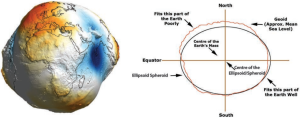
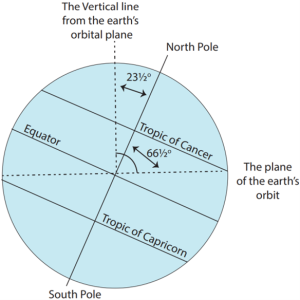
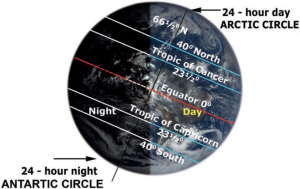
Difference between Rotation and Revolution
Rotation | Revolution |
· Spinning of the earth from west to east on its axis. | · Movement of the earth around the sun in its elliptical orbit. |
· It takes 24 hours to complete a rotation (or a day) | · It takes 365¼ days to complete one revolution (or a year) |
· It is known as the daily or diurnal movement. | · It is known as the annual movement of the earth. |
· Rotation causes days and nights to alternate, tides, deflection of winds and ocean currents and also gives the earth its shape. | · Revolution results in the varying lengths of day and night, changes in the altitude of the midday sun and change of seasons. |
Period of Revolution and Leap year:
- The period of time the earth takes to make one revolution around the sun determines the length of one year.
- The earth takes 365 days and 6 hours to complete one revolution.
- Earth takes 365.25 days to complete one trip around the Sun.
- That extra quarter of a day presents a challenge to our calendar system, which has one year as 365 days.
- To keep our yearly calendars consistent with our orbit around the Sun once in, every four years we add one day.
- The extra day added to is called a leap day, and the year the extra day is added to is called a leap year.
- The extra day is added to the month of February which has 29 days in a leap year.
Effects of revolution of the earth:
The revolution of the earth around the sun results in the following
- Cycle of seasons,
- Variation in length of days and nights,
- Variation in distribution of solar energy over the earth and the temperature zones.
The Seasons Caused by Earth’s Rotation:
- The seasons are caused due to the combined effect of the earth’s revolution and the tilt of its axis to 23½° in the same direction throughout the year.
- In general, spring, summer, autumn and winter are the four seasons.
- The latitude at which the sun appears directly overhead changes as the earth orbits the sun.
- The sun appears to follow a yearly pattern of northward and southward motion in the sky, known as the ‘apparent movement of the sun’.
- It gives an impression that the sun is continuously swinging north and south of the equator.
- Actually, it is the earth that is moving around the sun on its tilted axis.
- It varies when observed on a daily and monthly basis, at different times of the year.
- On 21 March and 23 September, the sun rises precisely in the east and sets exactly in the west.
Equinoxes and solstices:
- You already knew that the sunrays are vertical at noon.
- The vertical rays fall on a small area, giving more heat.
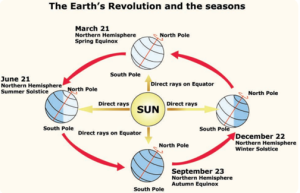
Equinoxes:
Position of the earth on 21 March:
- Equinoxes occur when the earth reaches the points in its orbits where the equatorial and the orbital planes intersect, causing the sun to appear directly overhead at the equator.
- During the equinoxes the periods of day light and darkness are equal all over the world.
- On 21 March the sun is directly overhead at the equator.
- Throughout the world, on this day all the places experience almost equal hours of day and night.
- This position of the sun is called spring equinox.
Position of the earth on 23 September:
- Neither pole of the earth is inclined towards the sun.
- The rays of the sun fall vertically on the equator.
- All the places have equal days and nights.
- It is autumn in the northern hemisphere and spring in the southern hemisphere.
- Again, on 23 September the sun is directly overhead on the equator and it is called autumn equinox.
- This day (23 September) when sun’s rays for fall vertically on the equator, is known as autumnal equinox.
Solstices Position of the earth on 21 June:
- The North Pole is inclined or tilted towards the sun.
- It, therefore, experiences complete light for 24 hours.
- The South Pole is tilted away from the sun so it is in complete darkness for 24 hours.
- The rays of the sun fall vertically at the tropic of cancer (23½º N).
- In the Northern hemisphere, the days are longer than the nights.
- It is summer in the northern hemisphere and winter in the southern hemisphere.
- The day 21 June is known as summer solstice.
Position of the earth on 22 December:
- The South Pole is inclined towards the sun and the North Pole is away from it.
- The rays of the sun fall vertically at the tropic of Capricorn (23½° S).
- The greater part of the southern hemisphere gets the direct rays of the sun so the days are long and the nights are short here.
- In the northern hemisphere the nights are longer than the days at this time.
- The southern hemisphere has summer.
- The northern hemisphere has winter.
- This day (22 December), when the sun’s rays fall vertically on the Tropic of Capricorn, is known as winter solstice.
Eclipse:
- Let us understand the effect of the revolution of the earth on the length of the days and the nights.
- The duration of the daylight varies with latitude and seasons.
- An eclipse is a complete or partial obscuration of light from a celestial body and it passes through the shadow of another celestial body.
- The eclipses are of two types. They are:
- Solar Eclipse:
- It occurs on New Moon days, when the moon is between the Sun and the Earth.
- Thus it obscures a part of the Sun viewed from the Earth, but only from a small area of the world.
- It lasts only for a few minutes.
- A partial solar eclipse happens when the moon partially covers the disc of the sun.
- An annular solar eclipse occurs when the moon passes centrally across the solar disc.
- During a total solar eclipse, the moon’s shadow is short enough to cover the whole sun.
- The outer regions still glow and look bright as a ring.
- Such a phenomenon is called Diamond Ring.
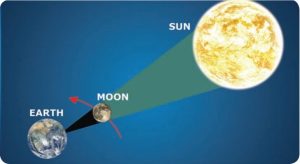
- Lunar Eclipse:
- It occurs on a Full Moon position when the earth is between the sun and the moon.
- The earth’s shadow obscures the moon as viewed from the earth.
- A partial lunar eclipse can be observed when only a part of the moon’s surface is obscured by earth’s umbra.
- A penumbral lunar eclipse happens when the moon travels through the faint penumbral portion of the earth’s shadow.
- A total lunar eclipse occurs when the earth umbra obscures the entire the moon’s surface.
- Lunar eclipse can be seen from anywhere on the night side of the Earth.
- It lasts for a few hours due to the smaller size of the moon.
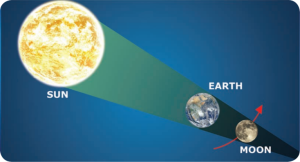
The Different Stages of Growth of the Moon:
- The changing angles between the earth, the sun and the moon determine the phases of the moon.
- Phases of the moon start from the ‘New Moon’ every month.
- Then, only a part of the Moon is seen bright called ‘Crescent’, which develops into the ‘first quarter’.
- With the increasing brightness it turns into three quarters known as ‘Gibbous’ and then it becomes a ‘Full Moon’.
- These stages are the waxing moon.
- After the full moon, the moon starts waning or receding through the stages of Gibbous, last quarter, crescent, and finally becomes invisible as dark New Moon.
The varying lengths of daylight in different latitudes:
- It is evident from the table that the duration of daylight is 12 hours throughout the year at the equator only.
- As one moves away from the equator, the seasonal variations in the duration of daylight increase.
- The seasonal variations in the duration of daylight are maximum at the polar region.
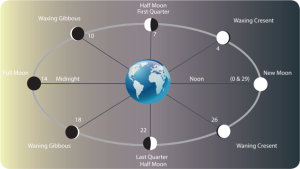
The Consequences of the Earth Being Spherical:
Variation in the amount of solar radiation received:
- If the earth were a flat surface, oriented at right angle to the sun, all the places on the earth would have received the same amount of radiation.
- But the earth is spherical/ geoids.
- Hence the sunrays do not heat the higher latitudes of the earth as much as the tropics.
- On any given day only, the places located at particular latitude receive vertical rays from the sun.
- As we move north or south of this location, the sun’s rays strike at decreasing angles.
- The yearly fluctuations in the angle of the sun’s rays and the length of the days change with the continual change of the earth’s position in its orbit around the sun at an inclination of 66½ to the orbital plane.
The angle of the sun’s rays striking different parts of the earth:
- Away from the equator, the sun’s rays strike the earth’s surface at particular angle.
- The slanting rays are spread over a large area and do not heat with the same intensity as the direct rays.
- As we go pole wards, the rays spread over the regions beyond the Arctic and the Antarctic circles in an extremely slanting manner.
- This is how we get the various temperature zones.
- Lower the degree of latitude; higher the temperature.
- Not only that, the rays striking at a low angle must travel through a greater thickness of the atmosphere than the rays striking at a higher angle.
- The rays striking at a lower angle are subject to greater depletion by reflection and absorption by the atmosphere.
Heat zones:
- The spherical shape of the earth along with its movement around the sun causes differences in the angles at which the sun’s ray fall on the earth’s surface.
- This causes a difference in the distribution of heat on the earth’s surface.
- As a result, the world has been divided into three distinct heat zones or temperature zones.
- They are the Torrid Zone, Temperate zone and Frigid Zone.
The Secret of the Pyramids:
- Secret to Great Pyramid’s Near Perfect Alignment Possibly Found!
- The Great Pyramid of Giza, 4,500 years ago, is an ancient feat of engineering.
- Now an archaeologist has figured out how the Egyptians may have aligned the pyramid almost perfectly along the cardinal points, north-south-east-west.
- Egyptians may have used the autumn equinox.
- Methods used by the ancient Egyptians to align the pyramids along the cardinal points are accurate.
- On the day of the fall equinox, a surveyor placed a rod into the ground and tracked its shadow throughout the day.
- The result was a line running almost perfectly east-west.
- The Egyptians could have determined the day of the fall equinox by counting forward 91 days after the summer solstice.
Black Holes:
- Gravitational waves are the disturbances in the curvature of space-time and it travels with speed of light.
- Any accelerated charge emits electromagnetic wave.
- Similarly, any accelerated mass emits gravitational waves but these waves are very weak even for masses like earth.
- e strongest source of gravitational waves are black holes.
- E discovery of gravitational waves made it possible to study the structure of black holes since it is the strongest source of gravitational waves.
- In fact, the recent discoveries of gravitational waves are emitted by two black holes when they merge to a single black hole.
- In fact, Albert Einstein theoretically proposed the existence of ‘gravitational waves’ in the year 1915.
- Are 100 years, it is experimentally proved that his predictions are correct.
Gravitational Waves:
- Black holes are end stage of stars which are highly dense massive object.
- Its mass ranges from 20 times mass of the sun to 1 million times mass of the sun.
- It has very strong gravitational force such that no particle or even light can escape from it.
- e existence of black holes is studied when the stars orbiting the black hole behave differently from the other stars.
- Every galaxy has black hole at its center.
- Sagittarius A* is the black hole at the center of the Milky Way galaxy.
